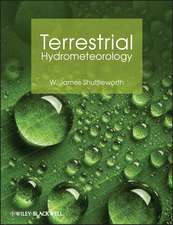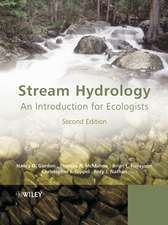Springs and Bottled Waters of the World: Ancient History, Source, Occurrence, Quality and Use
Editat de Philip E. LaMoreaux, Judy T. Tanneren Limba Engleză Hardback – 26 iul 2001
| Toate formatele și edițiile | Preț | Express |
|---|---|---|
| Paperback (1) | 643.81 lei 43-57 zile | |
| Springer Berlin, Heidelberg – 22 aug 2014 | 643.81 lei 43-57 zile | |
| Hardback (1) | 581.95 lei 38-44 zile | |
| Springer Berlin, Heidelberg – 26 iul 2001 | 581.95 lei 38-44 zile |
Preț: 581.95 lei
Preț vechi: 727.44 lei
-20% Nou
Puncte Express: 873
Preț estimativ în valută:
111.37€ • 115.84$ • 91.94£
111.37€ • 115.84$ • 91.94£
Carte tipărită la comandă
Livrare economică 09-15 aprilie
Preluare comenzi: 021 569.72.76
Specificații
ISBN-13: 9783540618416
ISBN-10: 3540618414
Pagini: 336
Ilustrații: XX, 315 p.
Dimensiuni: 210 x 279 x 24 mm
Greutate: 0.76 kg
Ediția:2001
Editura: Springer Berlin, Heidelberg
Colecția Springer
Locul publicării:Berlin, Heidelberg, Germany
ISBN-10: 3540618414
Pagini: 336
Ilustrații: XX, 315 p.
Dimensiuni: 210 x 279 x 24 mm
Greutate: 0.76 kg
Ediția:2001
Editura: Springer Berlin, Heidelberg
Colecția Springer
Locul publicării:Berlin, Heidelberg, Germany
Public țintă
ResearchDescriere
Springs and Bottled Waters of the World provides information for the general public, legal and scientific professionals, and governmental scientists about springs, mineral water, and thermal waters used for municipal, industrial, and agricultural water supplies as well as for the rapidly expanding bottled water industry. The role of springs is described for ancient civilizations, military campaigns and, in more recent times, for tourism and health spas of the world. In addition, their source, occurrence, and methods for development and use are described. In the preparation of this book data were obtained from major hydrogeologic data bases and from leading hydrogeologists.
Cuprins
1 Introduction.- 1.1 Purpose and Scope.- 1.2 The History of Mineral Water Exploitation in China.- 1.2.1 The Uses of Mineral Water in Ancient China.- 1.3 The Floridan Aquifer — A Type Locality for Springs — The Fountain of Youth.- 1.4 The Edwards Aquifer, Texas.- 1.5 Springs — Sources of Water, Industry, Art Form, Mythology.- 1.6 Political/Legal Aspects of Springs.- 1.7 Alcoholic Beverage Manufacturing.- 1.8 Bottled Water from Wells.- 1.9 Sources of Reference.- References.- 2 Historical Development.- 2.1 Introduction.- 2.2 Origin of Rivers and Springs.- 2.2.1 Evaporation and the Origin of Springs.- 2.2.2 Capillary Theory of Springs.- 2.3 Groundwater Utilization.- 2.4 Religion, Springs and the Bible.- 2.4.1 Figeh Spring — Damascus, Syria.- References.- 3 Geologic/Hydrogeologic Setting and Classification of Springs.- 3.1 Introduction.- 3.2 Hydrologic Cycle.- 3.2.1 Precipitation.- 3.2.2 Evapotranspiration.- 3.2.3 Runoff.- 3.2.4 Recharge.- 3.2.5 Storage.- 3.2.6 Spring Discharge.- 3.3 Classification and Geologic Setting.- 3.4 Past Civilizations.- 3.4.1 Spring Identification by Human Senses.- 3.5 Classification Prior to the 17th Century.- 3.5.1 Scientific Awakening.- 3.5.2 Instrumentation and Quantification.- 3.5.3 Scientific Specialization.- 3.5.4 Exploration.- 3.6 Documentation and Classification of Springs — Early 1900s.- 3.7 Current Classification.- 3.8 Present Documentation and Classification.- 3.8.1 Instrumentation and Quantification.- 3.9 Classification of Springs Documented by Computer Databases.- 3.10 Future Trends.- 3.11 Process.- 3.12 Karst Springs.- 3.13 Thermal Springs.- 3.14 Structurally Controlled Springs.- 3.15 Miscellaneous.- References.- 4 Extracting Methods for Spring Waters.- 4.1 Introduction.- 4.2 Collection Systems for Spring Waters.- 4.3 Locating Springs for Spring Water Development.- 4.4 Advantages of Proper Extraction of Spring Water.- 4.5 Extracting Methods for Spring Waters.- 4.6 Collecting Spring Water at Original Point of Spring Discharge.- 4.7 Diverting and Collecting Spring Water by Blocking Original Discharge Point.- 4.8 Extracting Spring Water by Subsurface Channels or Pipes.- 4.9 Extracting Spring Water by Shaft and/or Collection Gallery System.- 4.10 Extracting Spring Water by Boreholes.- 4.10.1 Hydrogeologic Methods.- 4.10.2 Geochemical Methods.- 4.11 Conclusions.- References.- 5 Quantitative Analysis of Springs.- 5.1 Introduction.- 5.2 Test Design Characteristics.- 5.3 Analysis of Pumping Test Data.- 5.4 Analysis of Aquifer Systems Hydraulically Connected to Springs.- 5.5 Groundwater Recharge.- 5.5.1 Precipitation.- 5.5.2 Evapotranspiration.- 5.5.3 Runoff.- 5.5.4 Water Budget.- 5.6 Geophysical Logging of Boreholes Associated with Spring Studies.- 5.7 Remote Sensing Techniques.- 5.8 Spring Hydrograph Analysis.- 5.9 Hydrograph Recessions.- 5.10 Water Tracing Techniques.- 5.11 Use of Naturally Occurring Tracers.- 5.11.1 Naturally Occurring Microorganisms.- 5.11.2 Ions in Solution.- 5.11.3 Environmental Isotopes.- 5.11.4 Radioactive Isotopes.- 5.11.5 Stable Isotopes.- 5.11.6 Use of Artificial Tracers.- 5.11.7 Radiometrically Detectable Tracers.- 5.11.8 Dyes as Water Tracers.- References.- 6 Uses of Spring Water.- 6.1 Introduction.- 6.2 Bottled Water.- 6.3 Labels and Art Forms.- 6.4 Water on the World Wide Web.- 6.5 Medicinal Values.- 6.6 Mineral Exploration Using Artesian Well Spring Water.- 6.7 Spas of Renown.- References.- 7 In Search of a Uniform Standard for Bottled Water.- 7.1 Introduction.- 7.2 Social, Economic, Cultural, and Environmental Impacts on Bottled Water Use.- 7.3 Regulatory Environment.- 7.3.1 United States of America.- 7.3.2 Federal Food, Drug and Cosmetic Act: Regulatory Scheme of FDA over Foods Generally.- 7.3.3 Federal Food, Drug and Cosmetic Act: Regulatory Scheme of FDA over Bottled Water Specifically.- 7.3.4 Current USA Food and Drug Administration Regulations.- 7.3.5 Regulatory Environment at the State Level and Self-Regulation in the United States of America.- 7.4 European Economic Community.- 7.5 The World Health Organization.- 7.6 WHO Microbiological and Biological Aspects of Bottled Water Quality.- 7.6.1 WHO Chemical Quality.- 7.6.2 WHO Radioactive Materials.- 7.6.3 Labeling.- 7.7 Conclusions.- References.- 8 Famous Springs and Bottled Waters.- 8.1 Introduction.- References.- 8.2 Silver Springs, Florida, USA.- 8.2.1 Introduction.- 8.2.2 Location.- 8.2.3 Background and Description.- 8.2.4 Discharge and chemistry.- 8.2.5 Hydrogeology.- References.- 8.3 Springs of Great Britain.- 8.4 The Waters of Hot Springs National Park, Arkansas, USA — Nature and Origin.- 8.4.1 Introduction.- 8.4.2 Hot Springs — Their Flow, Chemical Characteristics and Age.- References.- 8.5 Main Karstic Springs of Israel.- 8.5.1 Introduction.- 8.5.2 Western Watershed.- 8.5.3 Eastern Watershed.- 8.6 Kadesh Barnea.- References.- 8.7 Mallow Springs, County Cork, Ireland.- 8.7.1 Introduction.- 8.7.2 History of Mallow Springs.- 8.7.3 Geological setting of Mallow Springs.- 8.7.4 Flow and Temperature of the Springs.- 8.7.5 Chemistry of Mallow Springs.- 8.7.6 Use of Mallow Springs — Present and Future.- Acknowledgements.- References.- 8.8 Lisdoonvarna Springs and Spa Wells, County Clare, Ireland.- 8.8.1 Introduction.- 8.8.2 Geological Setting.- 8.8.3 Hydrology and Chemistry of the Springs.- 8.8.4 History of the Spa Waters.- References.- 8.9 Springs in Egypt.- 8.9.1 Introduction.- 8.9.2 Springs of Sinai.- 8.9.3 Springs in the Western Desert.- 8.9.4 Nubian Sandstone Aquifer System in the Western Desert, Egypt.- 8.9.5 Springs of Siwa Oasis.- References.- 8.10 Ombla Spring, Croatia.- 8.10.1 Introduction.- 8.10.2 Outlines of Geology.- 8.10.3 Hydrological Setting.- 8.10.4 Main Features of Ombla Karstic Aquifer.- 8.10.5 Characteristics of the Spring Zone.- 8.10.6 Possibilities for underground dam construction.- References.- 8.11 The Spa of Baden-Baden, Germany.- 8.11.1 Introduction.- 8.11.2 History.- 8.11.3 Geological Setting.- 8.11.4 Hydrogeology.- References.- 8.12 Source of the Shannon.- Acknowledgements.- References.- 8.13 The Fountains of Pretoria.- 8.13.1 Introduction.- 8.13.2 Background.- 8.13.3 The Pretoria Fountains.- 8.13.4 Hydrogeological Setting.- 8.13.5 Flow Characteristics.- 8.13.6 Hydrochemistry.- 8.13.7 Remarks.- Acknowledgements.- References.- 8.14 Springs of Japan.- 8.14.1 Introduction.- 8.14.2 Mount Fuji Area.- 8.14.3 Mount Aso Area.- 8.14.4 Akiyoshidai Area.- References.- 8.15 Thermal Mineral Water Springs in Karlovy Vary.- 8.15.1 Introduction.- 8.15.2 Mineral Waters in Western Bohemia.- 8.15.3 Historical Background.- 8.15.4 Geologic and Hydrologic Setting.- 8.15.5 Methods of Development and Use.- 8.15.6 Chemical Character and Temperature.- 8.15.7 Thermal Water Protection.- References.- 8.16 Mineral Waters in Italy.- 8.16.1 Introduction.- 8.16.2 Bottled Waters in Italy.- 8.17 Origin of the Danube-Aach System.- 8.17.1 Introduction.- 8.17.2 Geological Setting.- 8.17.3 Development of the Danubian Drainage Pattern.- 8.17.4 The Underground Danube-Aach System.- 8.17.5 Tracing Experiments.- 8.17.6 Hydrochemistry of Karst Water.- 8.17.7 Evolution of the Danube-Aach System.- References.- 8.18 Water Supply of Rome in Antiquity and Today.- 8.18.1 Introduction.- 8.18.2 Ancient Water Supply of Rome (700 b.c.–a.d. 500).- 8.18.3 Aqua Applia.- 8.18.4 Anio Vetus.- 8.18.5 Aqua Marcia.- 8.18.6 Aqua Tepula and Aqua Julia.- 8.18.7 Aqua Virgo.- 8.18.8 Aqua Alsietina.- 8.18.9 Aqua Claudia.- 8.18.10 Anio Novus.- 8.18.11 Aqua Traiana.- 8.18.12 Aqua Alexandriana.- 8.18.13 Water Potential and Use in Antiquity.- 8.18.14 Decline and Revival of Rome Aqueducts (a.d. 500–1800).- 8.18.15 Modern Water Supply of Rome.- 8.18.16 Marcio Aqueduct.- 8.18.17 New Vergine Aqueduct.- 8.18.18 Water Wells.- 8.19 Thermal Springs in B?ile Herculane (Romania).- 8.19.1 Introduction.- 8.19.2 B?ile Herculane — Historical References.- 8.19.3 Geological and Hydrological Characteristics of the Area.- 8.19.4 General Characteristics of the Thermo-Mineral Sources.- 8.19.5 Geothermal Investigations.- Acknowledgements.- References.- 8.20 Ecology, Geochemistry and Balneology of Natural Medicinal Water Springs Used for Health Treatment (Tuva’s Arzhaan Project, Russia).- 8.20.1 Introduction.- 8.20.2 Expected Outcomes.- 8.21 Lakespring Hévíz — The Greatest Thermal Spring of Hungary.- 8.22 The Mineral Spring Water of QuDengNiMa, Tibet.- 8.23 Mineral Waters at Dudince Spa.- References.- 8.24 Les Bouillens, Source Perrier, Nimes, France.- 8.24.1 Introduction.- 8.24.2 History of Les Bouillens.- References.- 8.25 Badgastein Spa of Austria.- 8.25.1 Location.- 8.25.2 History.- 8.25.3 Geology.- 8.25.4 Hydrology.- 8.25.5 The Gastein-Böckstein Thermal Gallery.- 8.25.6 Indications and Medical Treatment: Bottled Water.- 8.25.7 Conventions and Meetings — Recreation and Sports.- References.- 8.26 The Karst System of the Fontaine de Vaucluse (Southeastern France).- 8.26.1 Introduction.- 8.26.2 Geography and Geology.- 8.26.3 Climate.- 8.26.4 Stratigraphy.- 8.26.5 Structure.- 8.27 Frido Springs — San Severino Lucano Territory (Southern Italy).- References.- 8.28 Environmental Factors and the Development of Bath Spa, England.- 8.28.1 Introduction.- 8.28.2 The Bath at Aquae Sulis.- 8.28.3 Thermal Water Springs of the Avon Valley.- 8.28.4 Recharge Mound at Bath.- 8.28.5 Statutory Control of Thermal Water at Bath.- 8.28.6 Structural Elements in Thermal and Groundwater Conservation.- 8.28.7 Geothermal Gradients.- 8.28.8 Origin of Bath Thermal Water.- 8.28.9 Age of Thermal Water Springs.- 8.28.10 Restoration of the Spa.- Acknowledgements.- References.- 8.29 Sasan and Taq-e-Bostan Karstic Springs, Iran.- 8.29.1 Sasan Karstic Spring.- 8.29.2 Taq-e-Bostan Karstic Spring.- 8.30 The Roman Springs of Israel.- 8.30.1 Introduction.- 8.30.2 General Setting.- 8.30.3 Conclusions.- References.- 8.31 Estonian Mineral and Bottled Waters.- 8.32 The History of Mineral Water Exploitation in China.- 8.32.1 Introduction.- 8.32.2 Uses of Mineral Water in Ancient China.- 8.32.3 Medical Use.- 8.32.4 Agriculture Use.- 8.32.5 Modern Bottled Mineral Water Industry in China.- 8.33 The Rhume Spring in the Foothills of the Harz Mountains, Northern Germany.- 8.33.1 Geological Framework.- 8.33.2 Hydrogeological Situation.- 8.33.3 Groundwater Tracer Tests.- 8.33.4 Groundwater Use and Protection.- References.- 8.34 Camp Holly Springs, Henrico County, Virginia, USA: A Case Study in “Springhead” Protection.- 8.34.1 Introduction.- 8.34.2 History of Camp Holly.- 8.34.3 Camp Holly Springs — Location.- Spring Water Quality Standards.- 8.34.5 Groundwater Resource (Spring) Protection.- 8.34.6 Summary and Conclusions.- Acknowledgements.- References.- 8.35 Piestany Thermal H2S Water and Mud.- 8.35.1 Introduction.- 8.35.2 Location.- 8.35.3 History.- 8.35.4 Discharge Rate.- 8.35.5 Use.- 8.35.6 Hydrogeology.- 8.35.7 Quality of Water.- References.- 8.36 Ballygowan Natural Mineral Water — History of the Source.- 8.36.1 Introduction.- 8.36.2 Location, Topography, and Drainage.- 8.36.3 Geology.- 8.36.4 Hydrogeology.- 8.36.5 Hydrochemistry.- 8.36.6 Well Field Management.- 8.36.7 Aquifer Protection.- References.- Conversion Tables.
Caracteristici
Thorough overview over the most spectacular springs in the world
Application to the mineral water industry
Legal regulations in US and Europe
Application to the mineral water industry
Legal regulations in US and Europe






